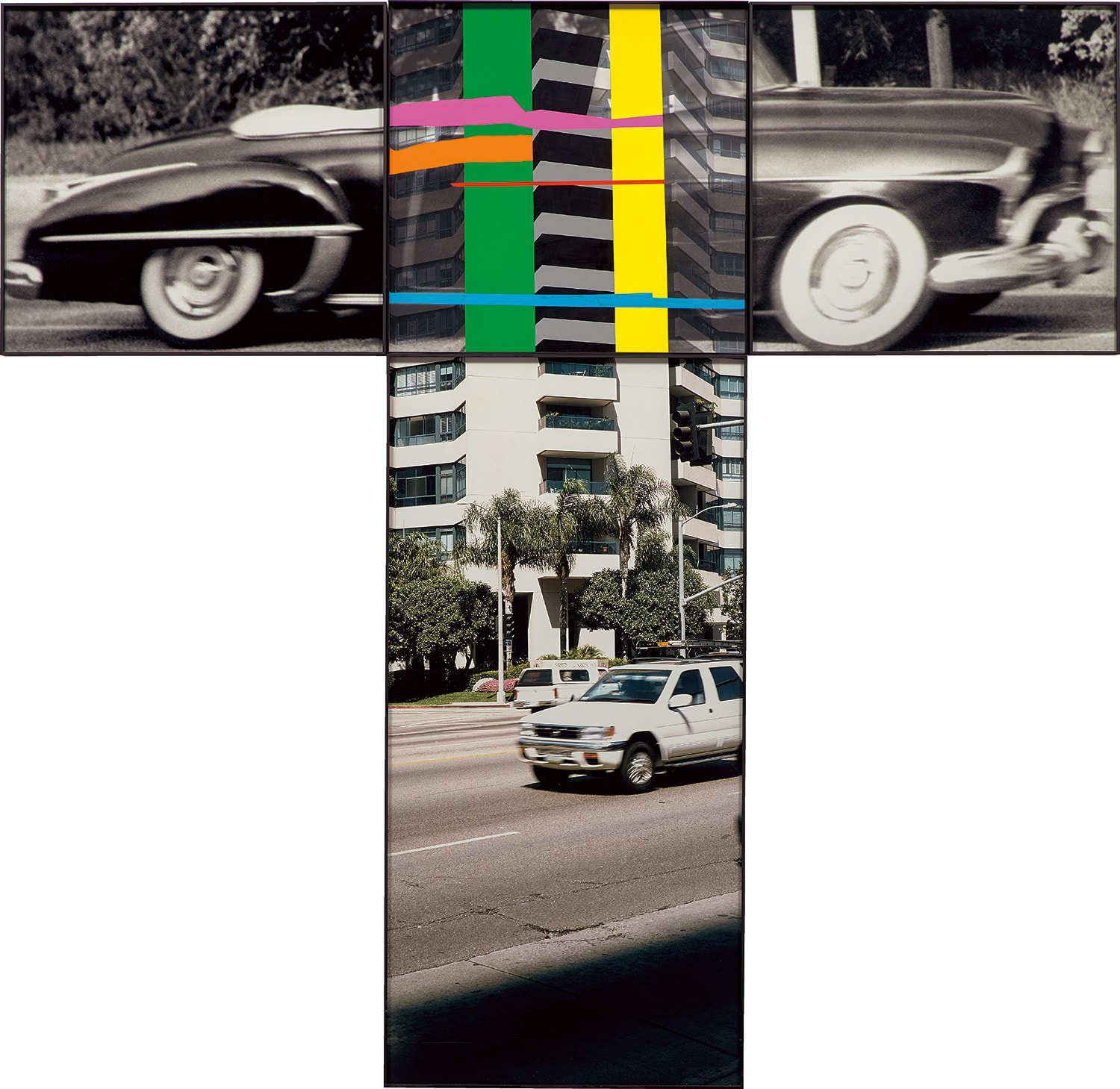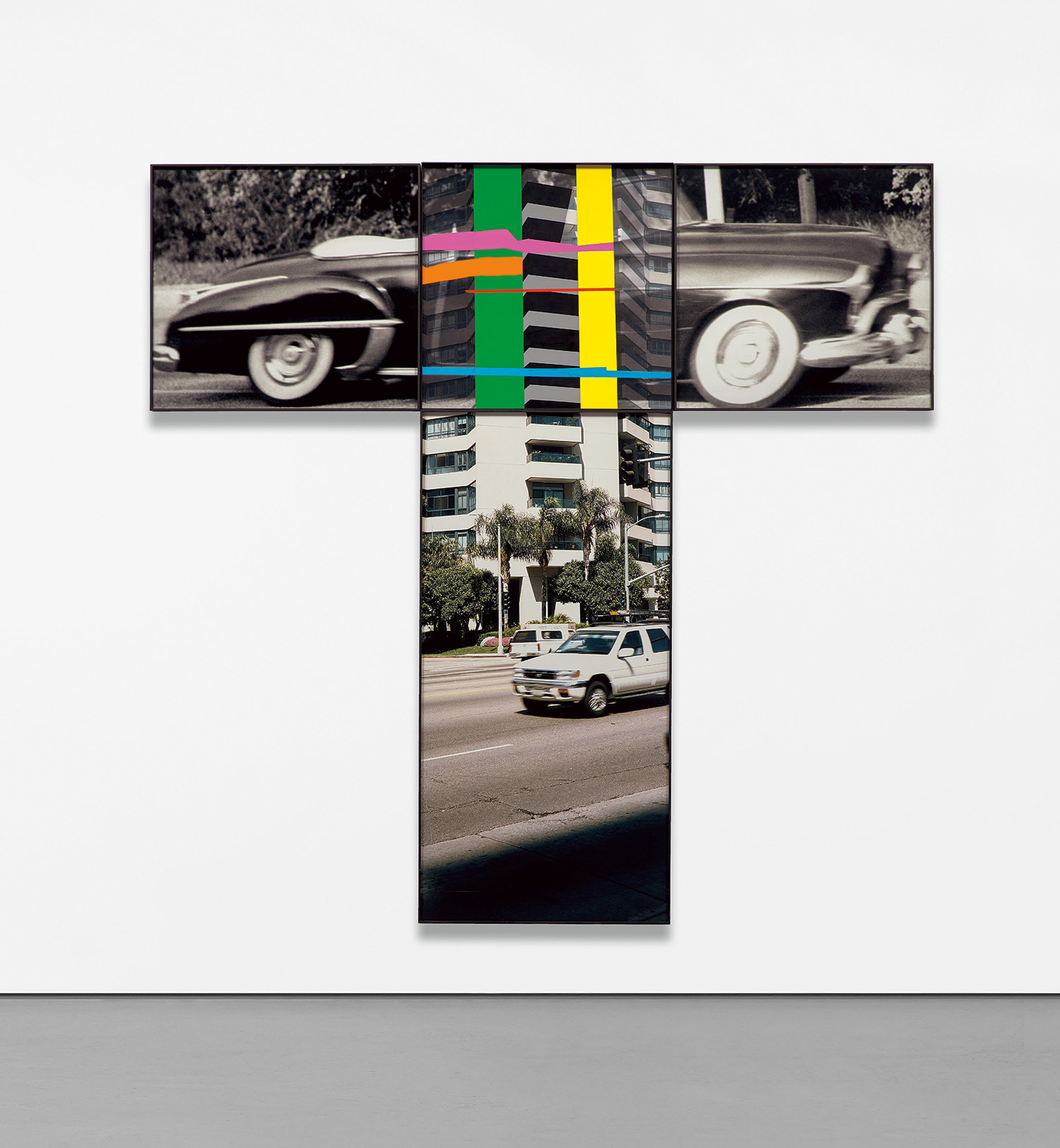



25Ο◆
John Baldessari
Intersection Series: Automobile / High Rise Building
digital photographic prints with acrylic on foam PVC board, in artist's frames, in 4 parts
overall 214.3 x 220.3 cm (84 3/8 x 86 3/4 in.)
Executed in 2002.
Full-Cataloguing
Towering over two metres high, John Baldessari’s Intersection Series: Automobile / High Rise Building, 2002, draws the viewer into of a prototypical Los Angeles cityscape that brilliantly merges reality and fiction. Powerfully capturing the dialectic between urban horizontality and verticality, Baldessari has here juxtaposed a tightly cropped, grayscale film still of a vintage automobile against a vertical colour photograph of a high-rise building – elevating the quintessentially American car within a monumental format reminiscent of a religious altarpiece. Bringing two seemingly unrelated images together to create a third picture at their point of intersection, the photographic composition’s source imagery is further abstracted by Baldessari’s signature strategy of blocking out shapes with vivid hues of paint. A quintessential example of the artist’s Intersection Series, of which another work resides in the Broad Museum, Los Angeles, the present work captures the idiosyncratic mash-up of painting, photography, and filmic source imagery that launched Baldessari’s career and has made him one of the most influential artists of his generation.
With Intersection Series: Automobile / High Rise Building, Baldessari expands on many of the core themes with which he launched his conceptual art practice. It was in the late 1960s that he turned away from painting – famously disavowing all work he had made between 1953 and 1966 in his Cremation project in 1970 – and instead explored a more open-ended approach to art-making that turned to photography as the main medium of expression and communication. The present work echoes Baldessari’s late 1960s National City series, which consisted of grainy images depicting the automotive landscape of his Southern California hometown. As Baldessari recalled, ‘I would drive around National City where I was living and randomly shoot out of the window with the camera without even looking and drive with the other hand’ (John Baldessari, quoted in Moira Roth, ‘Interview with John Baldessari’, 1973, X-TRA, Winter 2005, vol. 8, no. 2, online). The present work belongs to the sub-group of T-shaped works in the Intersection series that feature photographs Baldessari took along Wilshire Boulevard, the principal East-West road connecting Downtown Los Angeles to the ocean.
Since the turn of the 20th century, car culture has been inextricably linked to Wilshire – as automobile advancements allowed quicker travel, so, too, did the corridor rapidly develop and spur the westward movement of the affluent. In the Intersection series, Baldessari focuses his attention particularly on the West Los Angeles stretch of the road between Beverly Hills and Westwood: cars swoosh past what at first glance appear to be non-descript high-rise buildings, yet are in fact towering luxury condominiums. Figuring in strong opposition to the desolate cityscape of Baldessari’s native National City, these buildings take on a particular significance for the artist. As he explained, ‘…such buildings make me uneasy wherever they are, Central Park West in NYC, or any place in the world. Maybe it’s because I was raised in a low-income city…West LA is pretty much surface…’ (John Baldessari, quoted in ‘Artist’s Statements’, Patrick Pardo and Robert Dean, eds., John Baldessari. Catalogue Raisonné, Volume Four: 1994-2004, New Haven, 2017, p. 406).
It is this notion of surface and façade that Baldessari probes both conceptually and formally through the juxtaposition of a film still – an industrially manufactured image that here appears to symbolise the optimism and nostalgia of quintessentially American car culture similarly thematised by such artists as Ed Ruscha, James Rosenquist and Peter Cain. Merging photographic imagery from real life and movies, Baldessari opens up the field of meaning. As he explained, ‘The ‘Intersection’ Series is about different worlds colliding, where the essence of one is commingled/contaminated/merged with the other, especially at the point of juncture’ (John Baldessari, quoted in ‘Artist’s Statements’, Patrick Pardo and Robert Dean, eds., John Baldessari. Catalogue Raisonné, Volume Four: 1994-2004, New Haven, 2017, p. 406). While Baldessari throughout the decades employed strategies of cutting and editing to challenge notions of fixed meaning, it is in particular in his larger body of work from the 2000s – his Overlap, Intersection and Junction series – that he explored what Robert Storr has characterised as ‘morphologies of juxtaposition’ (Robert Storr, ‘Wise Guy’, Patrick Pardo and Robert Dean, eds., John Baldessari. Catalogue Raisonné, Volume Four: 1994-2004, New Haven, 2017, p. 11).
The areas of intersection convey a dual identity; they belong partly to both axes, yet are clearly differentiated through both the overlapping imagery and Baldessari’s painterly intervention. As Marie de Brugerolle has argued, ‘Baldessari…uses color and form to cut into perceived reality and project a new narrative’ (Marie de Brugerolle, ‘Holy Holograms from Hollywood: John Baldessari’s Dialectic Imagery’, John Baldessari, Pure Beauty, exh. cat., Tate Modern, London, 2010, p. 310). As such, it is not only reality and fiction, but crucially also painting and photography, that collide and merge in these hybridised spaces of intersection. Defying singular notions of the medium in this way, Intersection Series: Automobile / High Rise Building perhaps above all seems to capture how, as Baldessari put forward in his artist statement, ‘…lastly, such subject matter provides me with a reason to pursue two loves, painting and photography. But really one love – art’ (John Baldessari, quoted in ‘Artist’s Statements’, Patrick Pardo and Robert Dean, eds., John Baldessari. Catalogue Raisonné, Volume Four: 1994-2004, New Haven, 2017, p. 406).
With Intersection Series: Automobile / High Rise Building, Baldessari expands on many of the core themes with which he launched his conceptual art practice. It was in the late 1960s that he turned away from painting – famously disavowing all work he had made between 1953 and 1966 in his Cremation project in 1970 – and instead explored a more open-ended approach to art-making that turned to photography as the main medium of expression and communication. The present work echoes Baldessari’s late 1960s National City series, which consisted of grainy images depicting the automotive landscape of his Southern California hometown. As Baldessari recalled, ‘I would drive around National City where I was living and randomly shoot out of the window with the camera without even looking and drive with the other hand’ (John Baldessari, quoted in Moira Roth, ‘Interview with John Baldessari’, 1973, X-TRA, Winter 2005, vol. 8, no. 2, online). The present work belongs to the sub-group of T-shaped works in the Intersection series that feature photographs Baldessari took along Wilshire Boulevard, the principal East-West road connecting Downtown Los Angeles to the ocean.
Since the turn of the 20th century, car culture has been inextricably linked to Wilshire – as automobile advancements allowed quicker travel, so, too, did the corridor rapidly develop and spur the westward movement of the affluent. In the Intersection series, Baldessari focuses his attention particularly on the West Los Angeles stretch of the road between Beverly Hills and Westwood: cars swoosh past what at first glance appear to be non-descript high-rise buildings, yet are in fact towering luxury condominiums. Figuring in strong opposition to the desolate cityscape of Baldessari’s native National City, these buildings take on a particular significance for the artist. As he explained, ‘…such buildings make me uneasy wherever they are, Central Park West in NYC, or any place in the world. Maybe it’s because I was raised in a low-income city…West LA is pretty much surface…’ (John Baldessari, quoted in ‘Artist’s Statements’, Patrick Pardo and Robert Dean, eds., John Baldessari. Catalogue Raisonné, Volume Four: 1994-2004, New Haven, 2017, p. 406).
It is this notion of surface and façade that Baldessari probes both conceptually and formally through the juxtaposition of a film still – an industrially manufactured image that here appears to symbolise the optimism and nostalgia of quintessentially American car culture similarly thematised by such artists as Ed Ruscha, James Rosenquist and Peter Cain. Merging photographic imagery from real life and movies, Baldessari opens up the field of meaning. As he explained, ‘The ‘Intersection’ Series is about different worlds colliding, where the essence of one is commingled/contaminated/merged with the other, especially at the point of juncture’ (John Baldessari, quoted in ‘Artist’s Statements’, Patrick Pardo and Robert Dean, eds., John Baldessari. Catalogue Raisonné, Volume Four: 1994-2004, New Haven, 2017, p. 406). While Baldessari throughout the decades employed strategies of cutting and editing to challenge notions of fixed meaning, it is in particular in his larger body of work from the 2000s – his Overlap, Intersection and Junction series – that he explored what Robert Storr has characterised as ‘morphologies of juxtaposition’ (Robert Storr, ‘Wise Guy’, Patrick Pardo and Robert Dean, eds., John Baldessari. Catalogue Raisonné, Volume Four: 1994-2004, New Haven, 2017, p. 11).
The areas of intersection convey a dual identity; they belong partly to both axes, yet are clearly differentiated through both the overlapping imagery and Baldessari’s painterly intervention. As Marie de Brugerolle has argued, ‘Baldessari…uses color and form to cut into perceived reality and project a new narrative’ (Marie de Brugerolle, ‘Holy Holograms from Hollywood: John Baldessari’s Dialectic Imagery’, John Baldessari, Pure Beauty, exh. cat., Tate Modern, London, 2010, p. 310). As such, it is not only reality and fiction, but crucially also painting and photography, that collide and merge in these hybridised spaces of intersection. Defying singular notions of the medium in this way, Intersection Series: Automobile / High Rise Building perhaps above all seems to capture how, as Baldessari put forward in his artist statement, ‘…lastly, such subject matter provides me with a reason to pursue two loves, painting and photography. But really one love – art’ (John Baldessari, quoted in ‘Artist’s Statements’, Patrick Pardo and Robert Dean, eds., John Baldessari. Catalogue Raisonné, Volume Four: 1994-2004, New Haven, 2017, p. 406).